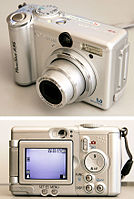
Photo from wikipedia
In thin-film transistor liquid crystal display (TFT-LCD) manufacturing, the automatic recognition and classification of defects can help manufacturers monitor abnormalities, identify potential process problems, and swiftly respond to these process… Click to show full abstract
In thin-film transistor liquid crystal display (TFT-LCD) manufacturing, the automatic recognition and classification of defects can help manufacturers monitor abnormalities, identify potential process problems, and swiftly respond to these process problems. Thus, yield loss can be reduced. However, capturing the content displayed on screen using cameras is challenging because it is often contaminated with moiré patterns. Moiré patterns originate from the interference between the pixel grids of inspection camera sensors and panel screens and adversely affect the visual quality of images, causing difficulty in determining the defect type, especially mura defects. Therefore, eliminating moiré patterns in defect images without impairing image quality is critical. However, moiré patterns are often dynamic and vary with sensor resolution, distance, and direction. Moreover, the frequency distribution of moiré patterns is broad, encompassing both low- and high-frequency components. Therefore, demoiréing is more challenging than other image restoration tasks. We investigated this problem and proposed an approach to eliminate moiré patterns from defect images based on a generative adversarial network architecture by using the U-net network as a generator and adding a discriminator. Moreover, we added an attention mechanism to focus on the local consistency of the restored moiré regions. The peak-signal-to-noise ratio (PSNR) and structural similarity index measure (SSIM) obtained using the proposed model were compared with those obtained using the U-net and pixel-to-pixel models. The experimental results of this study demonstrated that the proposed method can efficiently remove moiré patterns from defect images, and the proposed method quantitatively and qualitatively outperforms other methods.
Journal Title: IEEE Transactions on Semiconductor Manufacturing
Year Published: 2020
Link to full text (if available)
Share on Social Media: Sign Up to like & get
recommendations!